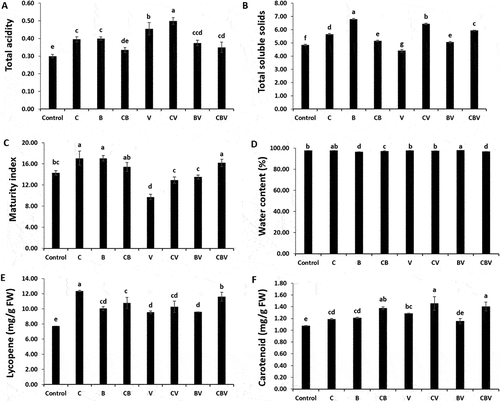Figures & data
Table 1. PGPR properties of the tested rhizobacteria.
Table 2. Result of three-way ANOVA test for independent variables including compost (C), PGPR (B), Verticillium dahliae (V) treatments and their interaction.
Fig. 1 (a) Plant height, (b) Number of leaves, (c) Total dry weight, (d) Total fresh weight of tomato plants infected by Verticillium dahliae or not in the presence of different biostimulant combination after 5 months of cultivation. Control; C: Compost; B: Plant growth-promoting Rhizobacteria; CB: Compost + Plant growth-promoting Rhizobacteria; V: V. dahliae; CV: Compost + V. dahliae; BV: Plant growth-promoting Rhizobacteria + V. dahliae; CBV: Compost + Plant Growth-promoting Rhizobacteria + V. dahliae. Data are based on five replicates; bars with different letters significantly differ according to Tukey’s HSD test at p < 0.05.
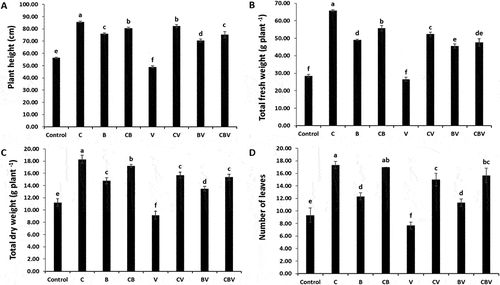
Fig. 2 (a) Photosynthetic efficiency and (b) stomatal conductance of tomato plants infected by Verticillium dahliae or not in the presence of different biostimulant combination after 5 months of cultivation. Control; C: Compost; B: Plant growth-promoting Rhizobacteria; CB: Compost + Plant growth-promoting Rhizobacteria; V: V. dahliae; CV: Compost + V. dahliae; BV: Plant growth-promoting Rhizobacteria + V. dahliae; CBV: Compost + plant growth-promoting Rhizobacteria + V. dahliae. Data are based on five replicates; bars with different letters significantly differ according to Tukey’s HSD test at p < 0.05.
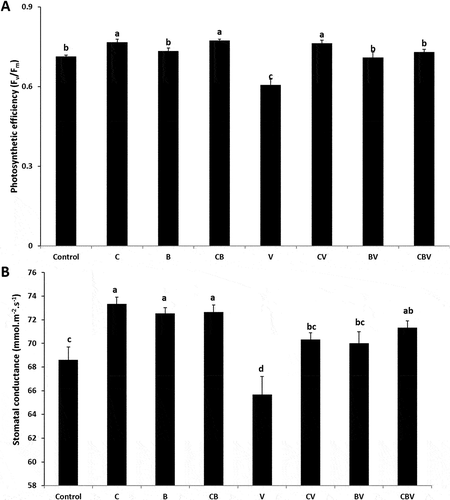
Fig. 3 (a) phosphorous, (b) potassium, (c) magnesium, (d) calcium, (e) sodium in the leaves of tomato plants infected by Verticillium dahliae or not in the presence of different biostimulants combination after 5 months of cultivation. Control; C: Compost; B: Plant growth-promoting Rhizobacteria; CB: Compost + Plant growth-promoting Rhizobacteria; V: V. dahliae; CV: Compost + V. dahliae; BV: Plant growth-promoting Rhizobacteria + V. dahliae; CBV: Compost + plant growth-promoting Rhizobacteria + V. dahliae. Data are based on five replicates; bars with different letters significantly differ according to Tukey’s HSD test at p < 0.05.
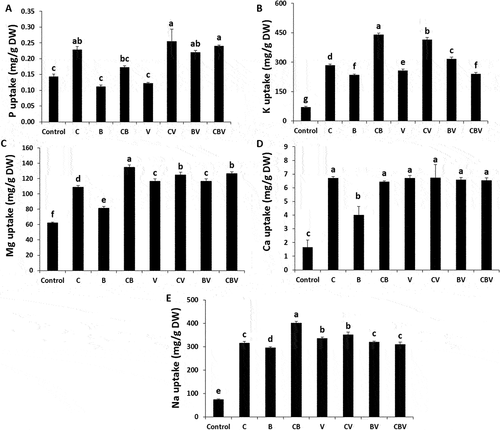
Fig. 4 Severity of the disease caused by Verticillium dahliae on tomato plants infected by V. dahliae in the presence of different biostimulant combination after 5 months of cultivation. V: V. dahliae; CV: Compost + V. dahliae; BV: Plant growth-promoting Rhizobacteria + V. dahliae; CBV: Compost + Plant growth-promoting Rhizobacteria + V. dahliae. Data are based on five replicates.
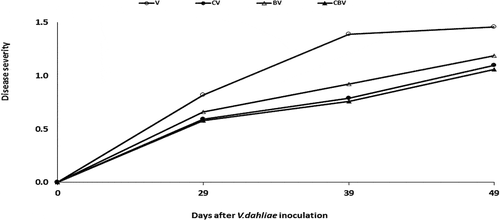
Fig. 5 (a) Disease incidence, (b) Leaf alteration index, (c) AUDPC, (d) FMS caused by Verticillium dahliae on tomato plants infected by V. dahliae in the presence of different biostimulant combination after 5 months of cultivation. V: V. dahliae; CV: Compost + V. dahliae; BV: Plant Growth-Promoting Rhizobacteria + V. dahliae; CBV: Compost + Plant Growth-Promoting Rhizobacteria + V. dahliae. Data are based on five replicates; bars with different letters significantly differ according to Tukey’s HSD test at p < 0.05.
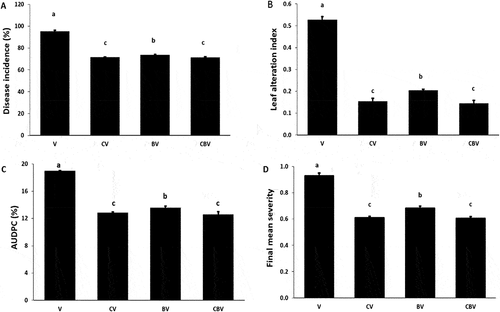
Fig. 6 (a) (H2O2) in the leaves, (b) in the root; Malondialdehyde MDA (c) in the leaves and (d) in the root of tomato plants infected by Verticillium dahliae or not in the presence of different biostimulant combination after 5 months of cultivation. Control; C: Compost; B: Plant Growth-Promoting Rhizobacteria; CB: Compost + Plant Growth-Promoting Rhizobacteria; V: V. dahliae; CV: Compost + V. dahliae; BV: Plant Growth-Promoting Rhizobacteria + V. dahliae; CBV: Compost + Plant Growth-Promoting Rhizobacteria + V. dahliae. Data are based on five replicates; bars with different letters significantly differ according to Tukey’s HSD test at p < 0.05.
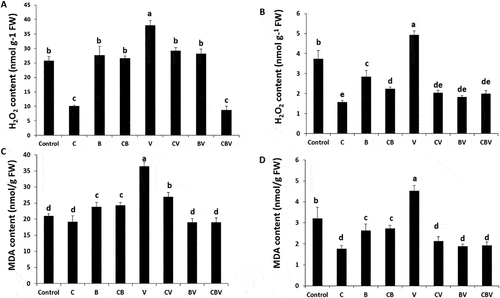
Fig. 7 (a) Peroxidase (POX), (b) Polyphenoloxidase (PPO), (c) Superoxide dismutase (SOD), (d) Catalase (CAT) in the leaves and roots of tomato plants infected or not by the pathogen Verticillium dahliae after 5 months. Data are based on five replicates; bars with different (n = 5) letters significantly differ according to Tukey’s HSD test at p < 0.05.
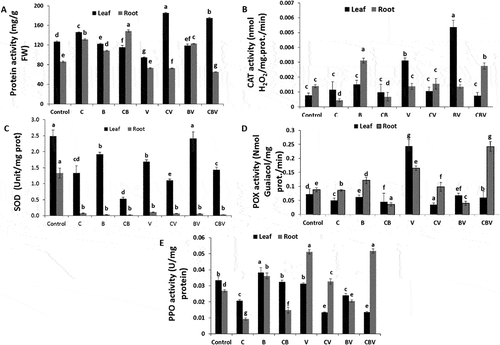
Fig. 8 (a) Total weight of tomato fruits; (b) Fruit number; (c): Fruit diameter of tomato plants infected by Verticillium dahliae or not in the presence of different biostimulant combination after 5 months of cultivation. Control; C: Compost; B: Plant Growth-Promoting Rhizobacteria; CB: Compost+ Plant Growth-Promoting Rhizobacteria; V: V. dahliae; CV: Compost + V. dahliae; BV: Plant Growth-Promoting Rhizobacteria + V. dahliae; CBV: Compost + Plant Growth-Promoting Rhizobacteria + V. dahliae. Data are based on five replicates; bars with different letters significantly differ according to Tukey’s HSD test at p < 0.05.
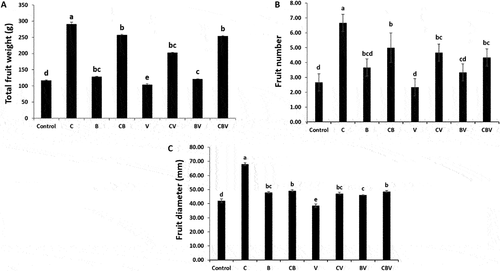
Fig. 9 (a) Total fruit weight, (b) Fruit number, (c) Fruit diameter, (d) Maturity index of tomato plants infected by Verticillium dahliae or not in the presence of different biostimulant combination after 5 months of cultivation. Control; C: Compost; B: Plant Growth-Promoting Rhizobacteria; CB: Compost+ Plant Growth-Promoting Rhizobacteria; V: V. dahliae; CV: Compost + V. dahliae; BV: Plant Growth-Promoting Rhizobacteria + V. dahliae; CBV: Compost + Plant Growth-Promoting Rhizobacteria + V. dahliae. Data are based on five replicates; bars with different letters significantly differ according to Tukey’s HSD test at p < 0.05.
